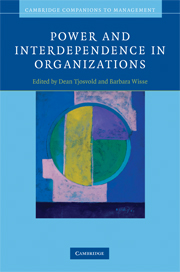Book contents
- Frontmatter
- Contents
- List of figures
- List of tables
- Foreword
- Introduction
- I Relationships to manage the faces of power
- II Participative leadership: Leading with others
- III Exchange dynamics and outcomes
- IV Power to influence
- V Leading with values
- 18 Servant-leadership, key to follower well-being
- 19 Ethical leadership: The socially responsible use of power
- 20 The Tao of value leadership and the power of interdependence
- Index
- References
20 - The Tao of value leadership and the power of interdependence
Published online by Cambridge University Press: 19 January 2010
- Frontmatter
- Contents
- List of figures
- List of tables
- Foreword
- Introduction
- I Relationships to manage the faces of power
- II Participative leadership: Leading with others
- III Exchange dynamics and outcomes
- IV Power to influence
- V Leading with values
- 18 Servant-leadership, key to follower well-being
- 19 Ethical leadership: The socially responsible use of power
- 20 The Tao of value leadership and the power of interdependence
- Index
- References
Summary
Introduction
The power impulse has two forms: explicit, in leaders; implicit, in their followers. When men willingly follow a leader, they do so with a view to the acquisition of power by the group which he commands, and they feel that his triumphs are theirs.
(Russell 1938: 16)The above averment by Bertrand Russell, the recipient of the 1950 Nobel Prize for literature, resonates with the Tao of value leadership. In his Book of Tao (Tao-Te-Ching), Lao-Tze says, “when people speak about a good emperor, they would say: ‘He has done this and he has done that.’ But when they speak of a superior emperor, they would say: ‘We have done it all ourselves’” (Siu 1980: 32). By the Tao of value leadership, we refer to the ultimate realm as well as the most desirable level leadership can reach: the level when leaders and followers share the same values and become truly interdependent and do their best to achieve their goals. In that process, leadership power, like energy in physics (Russell 1938), acts as a special type of force, not as “abilities” (e.g., Etzioni 1961; Pfeffer 1992) or “potential influence” (e.g., French and Raven 1959), enabling the leader to achieve the highest level.
Leadership power is “a special form of power,” which consists of two interrelated essentials “motive and resource” (Burns 1979: 12). “Lacking motive, resource diminishes; lacking resource, motive lies idle; lacking either one, power collapses” (Burns 1979: 12).
- Type
- Chapter
- Information
- Power and Interdependence in Organizations , pp. 355 - 371Publisher: Cambridge University PressPrint publication year: 2009

